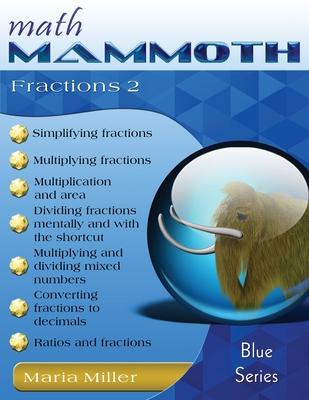Math Mammoth Fractions 2 continues the study of fraction topics after Math Mammoth Fractions 1. (I sincerely recommend that the student study the Fractions 1 book prior to studying this book, if he has not already done so.)
This book is meant for fifth grade, and deals in-depth with the following topics:
- simplifying; including simplifying before multiplying
- multiplication of fractions (and of mixed numbers)
- division of fractions
We start out by simplifying fractions. Since this process is the opposite of making equivalent fractions, studied in Math Mammoth Fractions 1, it should be relatively simple for students to understand. We also use the same visual model, just backwards: This time the pie pieces are joined together instead of split apart.
Next comes multiplying a fraction by a whole number. Since this can be solved by repeated addition, it is not a difficult concept at all.
Multiplying a fraction by a fraction is first explained as taking a certain part of a fraction, in order to teach the concept. After that, students are shown the usual shortcut for the multiplication of fractions.
Then, we find the area of a rectangle with fractional side lengths, and show that the area is the same as it would be found by multiplying the side lengths. Students multiply fractional side lengths to find areas of rectangles, and represent fraction products as rectangular areas.
Simplifying before multiplying is a process that is not absolutely necessary for fifth graders. I have included it here because it prepares students for the same process in future algebra studies and because it makes fraction multiplication easier.
Students also multiply mixed numbers, and study how multiplication can be seen as resizing or scaling. This means, for example, that the multiplication (2/3) 18 km can be thought of as finding two-thirds of 18 km.
Next, we study the division of fractions. The first lesson on the topic shows how fractions can be seen as divisions; in other words, for example, 5/3 is the same as 5 3. This of course gives us a means of dividing whole numbers and getting fractional answers (for example, 20 6 = 3 2/6).
The next lesson on the topic explores the thought of solving division problems by multiplying, and then introduces reciprocal numbers and the common shortcut for fraction division.
The following two lessons focus on two ways to think about division: equal sharing, and fitting the divisor (measurement division), and how they apply to fraction division. Here is an example of equal sharing: If two people equally share 4/5 of a pizza, how much will each person get? This is represented by the division (4/5) 2 = 2/5.
